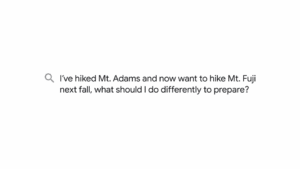Ok, let’s just clear something up. When we talk about Google’s MUM we don’t mean its mother! MUM stands for Multitask United Model – but more on that later.
Google has ramped up its investment in AI in recent years as part of its concerted effort to crack natural language understanding in search. When Google introduced MUM (Multitask United Model) this year, they revealed that it was 1000 times more powerful than their BERT update – which really shook the world of search up back in 2019.
What is MUM (Multitask United Model)?
Google’s Multitask United Model (MUM) is a new technology they have developed in order to answer complex questions that don’t have direct answers. It is a language model built on the same transformer system as BERT (Bidirectional Encoder Representations from Transformers), a powerful language model that proved to be a breakthrough in search on its release. With Google saying that MUM is 1000 times more powerful than BERT it isn’t hard to see why we think it will change search forever.
A lot of the power behind MUM comes from the fact that it can multitask. Now, this may not sound ground-breaking, but not having to do one task after another, instead of handling multiple tasks simultaneously is a breakthrough in the world of Artificial Intelligence. MUM can read text, understand the meaning behind that text, form deep knowledge of the topic the text is talking about, use audio and video to reinforce and enrich this knowledge, get insights into the topic from over 75 languages and then translate all of these findings into multi-layered content that answers the most complex questions. And it does all of this at once!

source: Google
A demonstration of the power of MUM
Prabhaka Raghaven, Senior Vice President at Google, revealed the power of MUM at a recent presentation he gave at Google’s I/O 2021 conference. To demonstrate what MUM could do he used the example of a complex query:
“I’ve hiked Mt. Adams and now want to hike Mt. Fuji next fall, what should I do differently to prepare?”

source: Google
Until now, if you were searching for the answer to this complex question, you would have had to search for all of the different aspects of the question yourself – such as ‘hiking Mt. Adams’, ‘preparing to hike Mt. Adams’, ‘hiking Mt. Fuji’, and so on. Then you would have to combine all of the information you have found into one answer.
What the introduction of MUM does is to combine insights from many different sources on many different aspects of the search, such as extracting information from Japanese sources about Mt. Fuji, measuring the difference in the height of the mountains, and even suggesting a raincoat as it is the rainy season when you are planning to hike there. The fact that it can extract this information from Japanese sources is really exciting from a search perspective because there will be more information about this specific topic in that language.
What this shows is that intent is really important in search and is what is driving Google’s investment and algorithm changes at the moment. Machines usually have difficulty in understanding human language, but language models such as BERT and MUM are getting closer to being able to do that.

source: Google
MUM goes a step further than BERT in that it can also add images and video as well as processing language, as it is multimodal. This makes it possible for Google to use it to generate a rich result that answers the search query by presenting a whole new piece of content.
Of course, the end goal for Google with all of this is to help the searcher to get more information with fewer search queries – within the boundaries of Google itself. As SEO experts, we have seen a steady increase in quick answers and rich results occurring on search engine results pages (SERPS) and they are getting more prominent by the day.
Google is currently testing MUM
Now, MUM has not been added to the Google systems yet – they are still in the testing phase with it. Although they haven’t given us a timeframe as to when it will go live, we don’t think it will take too long as BERT was added pretty quickly in 2019.
The introduction of MUM to the Google system may not only mean better search results for searchers, but also a new type of search result. One that is made up of information from various sources, pieced together into something new. This could have an impact on how we think about content for our clients. It may actually make it less important to solve your target audience’s problem and answer their questions, as this is already going to be done by Google. Instead, the focus may turn to building brand preference and improving your product and service offering – thinking about ways to stand out from your competition and turn your website traffic into customers for life.
How we will prepare for Google MUM
Google is constantly tweaking its algorithm at the moment to help it to get better at reading and understanding text in the same way as a human does. So, what can we do to help our clients to prepare for this new language model and the direction that Google is taking search in?
First of all, we need to give Google more insight into your content by adding structured data to pages. This helps Google to figure out what is on a page and can make your content eligible for rich results.
We also need to ensure that all of the content on your website is well-written, easy to read, and optimised in a natural way. We never keyword stuff content anyway, but always focus on creating content that your audience actually wants to read – original and new content with a good structure is key.
If you want your SEO strategy and content to keep up with Google’s algorithm updates and new technologies, get in touch with the expert team at Zool/
Google’s MUM is going to change search forever
Analytics Digital SEO / Aug 23, 2021
Ok, let’s just clear something up. When we talk about Google’s MUM we don’t mean its mother! MUM stands for Multitask United Model – but more on that later.
Google has ramped up its investment in AI in recent years as part of its concerted effort to crack natural language understanding in search. When Google introduced MUM (Multitask United Model) this year, they revealed that it was 1000 times more powerful than their BERT update – which really shook the world of search up back in 2019.
What is MUM (Multitask United Model)?
Google’s Multitask United Model (MUM) is a new technology they have developed in order to answer complex questions that don’t have direct answers. It is a language model built on the same transformer system as BERT (Bidirectional Encoder Representations from Transformers), a powerful language model that proved to be a breakthrough in search on its release. With Google saying that MUM is 1000 times more powerful than BERT it isn’t hard to see why we think it will change search forever.
A lot of the power behind MUM comes from the fact that it can multitask. Now, this may not sound ground-breaking, but not having to do one task after another, instead of handling multiple tasks simultaneously is a breakthrough in the world of Artificial Intelligence. MUM can read text, understand the meaning behind that text, form deep knowledge of the topic the text is talking about, use audio and video to reinforce and enrich this knowledge, get insights into the topic from over 75 languages and then translate all of these findings into multi-layered content that answers the most complex questions. And it does all of this at once!

source: Google
A demonstration of the power of MUM
Prabhaka Raghaven, Senior Vice President at Google, revealed the power of MUM at a recent presentation he gave at Google’s I/O 2021 conference. To demonstrate what MUM could do he used the example of a complex query:
“I’ve hiked Mt. Adams and now want to hike Mt. Fuji next fall, what should I do differently to prepare?”

source: Google
Until now, if you were searching for the answer to this complex question, you would have had to search for all of the different aspects of the question yourself – such as ‘hiking Mt. Adams’, ‘preparing to hike Mt. Adams’, ‘hiking Mt. Fuji’, and so on. Then you would have to combine all of the information you have found into one answer.
What the introduction of MUM does is to combine insights from many different sources on many different aspects of the search, such as extracting information from Japanese sources about Mt. Fuji, measuring the difference in the height of the mountains, and even suggesting a raincoat as it is the rainy season when you are planning to hike there. The fact that it can extract this information from Japanese sources is really exciting from a search perspective because there will be more information about this specific topic in that language.
What this shows is that intent is really important in search and is what is driving Google’s investment and algorithm changes at the moment. Machines usually have difficulty in understanding human language, but language models such as BERT and MUM are getting closer to being able to do that.

source: Google
MUM goes a step further than BERT in that it can also add images and video as well as processing language, as it is multimodal. This makes it possible for Google to use it to generate a rich result that answers the search query by presenting a whole new piece of content.
Of course, the end goal for Google with all of this is to help the searcher to get more information with fewer search queries – within the boundaries of Google itself. As SEO experts, we have seen a steady increase in quick answers and rich results occurring on search engine results pages (SERPS) and they are getting more prominent by the day.
Google is currently testing MUM
Now, MUM has not been added to the Google systems yet – they are still in the testing phase with it. Although they haven’t given us a timeframe as to when it will go live, we don’t think it will take too long as BERT was added pretty quickly in 2019.
The introduction of MUM to the Google system may not only mean better search results for searchers, but also a new type of search result. One that is made up of information from various sources, pieced together into something new. This could have an impact on how we think about content for our clients. It may actually make it less important to solve your target audience’s problem and answer their questions, as this is already going to be done by Google. Instead, the focus may turn to building brand preference and improving your product and service offering – thinking about ways to stand out from your competition and turn your website traffic into customers for life.
How we will prepare for Google MUM
Google is constantly tweaking its algorithm at the moment to help it to get better at reading and understanding text in the same way as a human does. So, what can we do to help our clients to prepare for this new language model and the direction that Google is taking search in?
First of all, we need to give Google more insight into your content by adding structured data to pages. This helps Google to figure out what is on a page and can make your content eligible for rich results.
We also need to ensure that all of the content on your website is well-written, easy to read, and optimised in a natural way. We never keyword stuff content anyway, but always focus on creating content that your audience actually wants to read – original and new content with a good structure is key.
If you want your SEO strategy and content to keep up with Google’s algorithm updates and new technologies, get in touch with the expert team at Zool/
Array
